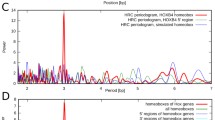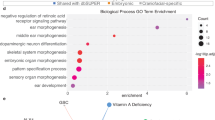Abstract
Homeobox genes, first identified in Drosophila, encode transcription factors that regulate embryonic development along the anteroposterior axis of an organism. Vertebrate homeobox genes are described on the basis of their homology to the genes found within the Drosophila Antennapedia and Bithorax homeotic gene complexes. Mammals possess four paralogous homeobox (HOX) gene clusters, HOX A, HOX B, HOX C and HOX D, each located on different chromosomes, consisting of 9 to 11 genes arranged in tandem. We report the characterization of the human HOX D1 gene. This gene consists of two exons, encoding a 328 amino acid protein, separated by an intron of 354 bp. The human HOX D1 protein is one amino acid longer (328 amino acids) than the mouse protein (327 amino acids) and is 82% identical to the mouse HOX D1 homolog. The DNA binding homeodomain region of the human protein exhibits a 97% and 80% identity between mouse Hoxd1 and Drosophila labial homeodomains, respectively. The exon/intron and intron/exon splice junctions are conserved in position between human and mouse genes. Determination of the human HOX D1 gene structure permits the use of PCR based analysis of this gene for the assessment of mutations, for diseases that link to the HOXD cluster (such as Duanes Retraction Syndrome (DRS)), or polymorphisms associated with human variation. Molecular characterization of the HOXD1 gene may also permit analysis of the functional role of this gene in human neurogenisis.
Similar content being viewed by others
References
Lewis EB (1978) Nature 7: 565–70.
Gehring WJ (1994). In: Duboule D (Ed) A History of the Homeobox: Guidebook to the Homeobox Genes (pp. 3–10). Oxford University Press, Oxford.
Laughon A & Scott MP (1984) Nature 310, 24–31.
Kaufman TC Lewis R & Wakimoto B (1980) Genetics 94: 115–133.
Scott MP (1993) Nucleic Acids Res. 21: 1687–1688.
Kappen C, Schughart K & Ruddle FH, (1989) Proc. Natl. Acad. Sci. USA 86: 5459–5463.
Boncinelli E, Somma R, Acampora D, Pannese M, D'Esposito M, Faiella A & Simeone A (1988) Human Reproduction 3: 880–886.
Mark M, Rijli FM & Chambon P (1997) Pediatric Research 4: 421–429.
Dubuole D & Dollé P (1989) EMBO J. 8: 1497–1505.
Gaunt SJ, Krumlauf R & Duboule D (1989) Development 107: 131–141.
Graham A, Papalopulu N & Krumlauf R (1989) Cell 57: 367–378.
Papalopulu N, Lovell-Badge R & Krumlauf R (1991) Nucleic Acids Res. 19: 5497–5506.
Simeone A, Acampora D, Nigro V, Faiella A, D'Esposito M, Stornaiuolo A, Mavilio F & Boncinelli E (1991) Mech. Dev. 33: 215–228.
Manley NR & Capecchi MR (1997) Dev. Biol. 192: 274–288.
Manley NR & Capecchi MR (1998) Dev. Biol. 195: 1–15.
Frohman MA, Boyle M & Martin G (1990) Development 110: 589–607.
Hunt P, Gulisano M, Cook M, Sham M-H, Faiella A, Wilkinson D, Boncinelli E & Krumlauf R (1991) Nature 353: 861–864.
Huber A (1974) Br. J. Ophthalmol. 58: 293–300.
Parsa CF, Grant E, Dillon WP Jr, du Lac S & Hoyt WF (1998) Am. J. Ophthalmol. 125: 399–401.
Hotchkiss MG, Miller NR, Clark AW & Green WR (1980) Arch. Ophthalmol. 98: 870–874.
Miller NR, Kiel SM, Green WR & Clark AW (1982) Arch. Ophthalmol. 100: 1468–1472.
Goddard JM, Rossei M, Manley NR & Capecchi MR (1996) Development 122: 3217–3228.
Stornaiuolo A, Acampora D, Pannese M, D'Esposito M, Morelli F, Migliaccio E, Rambaldi M, Faiella A, Nigro V, Simeone A & Boncinelli E (1990) Cell Differentiation and Development 31: 119–127.
Frohman MA & Martin GR (1992) Mech. Dev. 38: 55–67.
Laughon A (1991) Biochemistry 30: 11357–11367.
Acampora D, D'Esposito M, Faiella A, Pannese M, Migliaccio E, Morelli F, Stornaiuolo A, Nigro V, Simeone A & Boncinelli E (1989) Nucleic Acids Res. 17: 10385–10402.
Boncinelli E, Acampora D, Pannese M, D'Esposito M, Somma R, Gaudino G, Stornaiuolo A, Cafiero M, Faiella A & Simeone A (1989) Genome 31: 745–756.
Author information
Authors and Affiliations
Rights and permissions
About this article
Cite this article
Appukuttan, B., Sood, R., Ott, S. et al. Isolation and characterization of the human homeobox gene HOX D1. Mol Biol Rep 27, 195–201 (2000). https://doi.org/10.1023/A:1011048931477
Issue Date:
DOI: https://doi.org/10.1023/A:1011048931477




